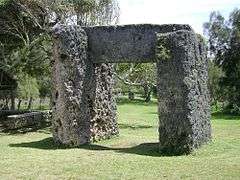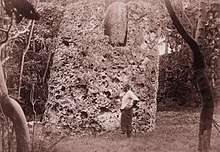Haʻamonga ʻa Maui


Haʻamonga ʻa Maui (Burden of Maui) is a stone trilithon located in Tonga, on the north of the island of Tongatapu, near the village of Niutōua, in Heketā.
History
The trilithon is constructed from three coral limestone slabs, and is up to 5.2 metres (17 ft) high, 1.4 m wide, and 5.8 m long. The weight of the visible part of each upright stone is approximately 30–40 tons. There are hewn deep mortises in the top of each upright stone to fit in the lintel.
Ha'amonga 'a Maui was either built at the beginning of the 13th century under the 11th Tuʻi Tonga Tuʻitātui (king strike the knee) and the high chief Loʻau, most likely as a gateway to his royal compound Heketā, or by the deified ancestor Maui in the 6th century, most likely as a astronomical observatory. One can pass through the portal and walk the short distance towards the ʻesi maka faakinanga (stone to lean against), which served as the king's throne. Sitting with his back to that stone, he was safe from assassins from behind, and with his long stick he could hit every potential foe from the front on his knees.
In Tongan tradition the Haʻamonga is also believed to have been made by the god Maui, as the stones would be too huge for mortals to handle. The word haʻamonga means "a stick with loads on both ends, carried over the shoulder". Maui was supposed to have the stones obtained from ʻUvea (Wallis Island) and carried on to Tonga in a giant canoe.
The resemblance of the trilithon with Stonehenge is often quoted, but Stonehenge has many more pillars and the lintels are on top of the sarsens, and not sunken down in a slit. Stonehenge may have been an archaeoastronomical observatory, as claimed by Gerald Hawkins in 1963. Nevertheless, this was enough for the king of Tonga Tāufaʻāhau Tupou IV to come in 1967 with the theory that the Haʻamonga had an astronomical significance too, telling the position of sunrise at solstices and equinoxes. This theory is supported by the research of Tongan historian Tevita Fale. [1] According to Tevita Fale, there is a V-shaped mark on top of the lintel that aligns with the rising of the sun during the solstices and equinoxes. [2]

Kik Velt disagrees with the findings of the king Tāufaʻāhau Tupou IV and Tevita Fale. Velt argues that the V on top is an arrow directed along the main axis of the lintel (about ESE, 117°5 E of N), only 10 cm long, too short to be a reliable indicator of any direction.
References
- K. Velt; Stars over Tonga; 1990
External links
![]()
Coordinates: 21°08′12″S 175°02′53″W / 21.13667°S 175.04806°W